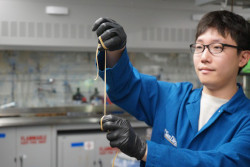Bacteria helps forever chemical decomposition
Researchers from the College of Engineering at Drexel University are attempting to determine how “forever chemicals” ended up in water, soil, crops, animals, and the blood of 97% of Americans.

According to their most recent research, the bacteria that assist in the decomposition of garbage and other biodegradable materials are probably responsible for the environmental release of the infamous per and polyfluoroalkyl substances(PFAS).
The team demonstrated how PFAS -chemicals that have been widely used in products that are resistant to heat, water, and stains and have been linked to serious health issues- can leach out of fertiliser made from recycled waste with the aid of microbial decomposition in a paper that was published in the journal Environmental Science:
Process & Impact. PFAS builds up in the soil, crops, and groundwater in farming throughout the nation.
https://www.sciencedaily.com/releases/2023/02/230215100446.htm
Asa Lewis, Ph.D., a coauthor and environmental engineer from Temple University led the research as doctoral student at Drexel. Because it is not currently possible to eliminate PFAS from the environment, it is important to understand everything we can about how it is able to persist and accumulate so broadly in the natural world.
Microbial weathering plays in the biosolids- to- PFAS dispersion route
Lewis stated the research demonstrates the role that microbial weathering plays in the biosolids- to- PFAS dispersion route.
Approximately 4.5 million metric tonnes or approximately half of all sewage waste in the United States, are processed and turned into biosolid waste, a type of sludge.
About half of that is processed further to get rid of biological and chemical impurities and is then turned into fertiliser. This fertiliser has been applied to agriculture, private gardens, and landscaping across the nation for the past 50 years.
However, studies in the past year have raised questions about its widespread use after finding that PFAS can linger in biosolids fertilisers despite being treated.
We wanted to investigate how microbial weathering of these organic compounds can impact PFAS leaching potential from biosolids over time because PFAS compounds are thought to stick to these compounds.
We know that microbes exist in biosolids sludge even after the stabilisation treatment process and given the role they play in the decomposition of organic compounds, such as fats,, protein, and polysaccharide residuals in the biosolids.
The team did this by gathering biosolids samples from wastewater recycling and reuse facilities that had undergone one of three methods of treatment: anaerobic digestion, or composting.
The initial amount of organic matter, proteins, and lipids, as well as the concentration of PFAS in these various forms of biosolids, were all examined in each sample’s composition,
These samples were taken kept in an environment-controlled chamber for three months in order to look for signs of microbial activity, particularly the breakdown of organics, lipids, and proteins, and to determine how this microbial activity affected how much PFAS would partition from the biosolids into water.
The sample with the highest levels of microbial activity also showed the highest levels of PFAS partitioning, the researchers discovered, suggesting that this biosolids sludge would be more prone to PFAS leaching.
The findings showed that the bacteria in the biosolids is likely contributed to the rise in PFAS partitioning throughout the course of the three months, particularly in the first 10 days of the experiment.
This permit the PFAS to spread, or partition, when water flows through the biosolids.
According to the authors, this work provides evidence that microbial weathering processes that result in the degradation of organic matter and biopolymers- as indicated by lipase activity, protease activity, and oxygen consumption rate, as well as changes in lipid, protein, and organic content – can impact PFAS partitioning and increase leaching potential in biosolids.
The team argues that knowing the trajectory of forever chemicals is crucial knowledge for authorities like the EPA to provide correct guidelines on PFAS risk and permissible levels of pollution.
According to Lewis, this research shows that PFAS can seep from biosolids across diverse stabilisation technique in wastewater treatment. And it lends additional credence to the idea that enhanced treatment in wastewater treatment plants or regulation are necessary to minimise environmental damage.
Source: ScienceDaily


